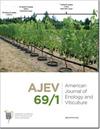避免红酒中组胺形成的酿酒葡萄球菌菌株:在实际酿酒条件下的研究
IF 1.8
3区 农林科学
Q3 BIOTECHNOLOGY & APPLIED MICROBIOLOGY
引用次数: 3
摘要
生产低生物胺(BA)浓度的葡萄酒是葡萄酒行业目前关注的问题,避免在酿酒过程中形成BA的策略尤其令人感兴趣。这项工作的目的是确定选定的本地酿酒球菌乳酸菌(LAB)对红葡萄酒中BA含量的影响,以及它们对本地微生物群的流行程度,以避免BA的形成。67款红葡萄酒是在真实的酿酒条件下连续三个年份以工业规模生产的。对于每种葡萄酒,我们确定了酿酒过程各个阶段的LAB植入和BA浓度。结果清楚地表明,使用选定的不能产生BA的O.oeni菌株,结合适应性的生物质生产,是控制葡萄酒中组胺生产的良好策略。这些连续三年进行的实践也被观察到,以确保选定的本地酿酒酵母菌株(CECT 9749)在整个酿酒厂中对其他本地微生物群的持久性。此外,对木桶中葡萄酒陈化过程中BA含量的分析表明,BA含量保持在较低水平,为消费者生产出更健康的葡萄酒。本文章由计算机程序翻译,如有差异,请以英文原文为准。
Autochthonous Oenococcus oeni Strain to Avoid Histamine Formation in Red Wines: A Study in Real Winemaking Conditions
The production of wines with low biogenic amine (BA) concentrations is a current concern in the wine sector, and strategies to avoid the formation of BAs during winemaking are of particular interest. The aim of this work was to determine the influence of selected autochthonous Oenococcus oeni lactic acid bacteria (LAB) on the BA content in red wines and their prevalence against the indigenous microbiota to avoid BA formation. Sixty-seven red wines were produced at industrial scale under real winemaking conditions for three consecutive vintages. For each wine, we determined LAB implantation and the BA concentrations at various stages of the winemaking process. The results clearly indicated that the use of selected O. oeni strains that are unable to produce BA, in combination with adapted biomass production, is a good strategy to control histamine production in wines. These practices, carried out over three consecutive years, were also observed to ensure the persistence of the selected autochthonous O. oeni strain (CECT 9749) against other indigenous microbiota in the entire winery. Furthermore, analysis of BA content during wine aging in barrels indicated that low BA content was maintained, resulting in healthier wines for the consumer.
求助全文
通过发布文献求助,成功后即可免费获取论文全文。
去求助
来源期刊

American Journal of Enology and Viticulture
农林科学-生物工程与应用微生物
CiteScore
3.80
自引率
10.50%
发文量
27
审稿时长
12-24 weeks
期刊介绍:
The American Journal of Enology and Viticulture (AJEV), published quarterly, is an official journal of the American Society for Enology and Viticulture (ASEV) and is the premier journal in the English language dedicated to scientific research on winemaking and grapegrowing. AJEV publishes full-length research papers, literature reviews, research notes, and technical briefs on various aspects of enology and viticulture, including wine chemistry, sensory science, process engineering, wine quality assessments, microbiology, methods development, plant pathogenesis, diseases and pests of grape, rootstock and clonal evaluation, effect of field practices, and grape genetics and breeding. All papers are peer reviewed, and authorship of papers is not limited to members of ASEV. The science editor, along with the viticulture, enology, and associate editors, are drawn from academic and research institutions worldwide and guide the content of the Journal.
 求助内容:
求助内容: 应助结果提醒方式:
应助结果提醒方式:


